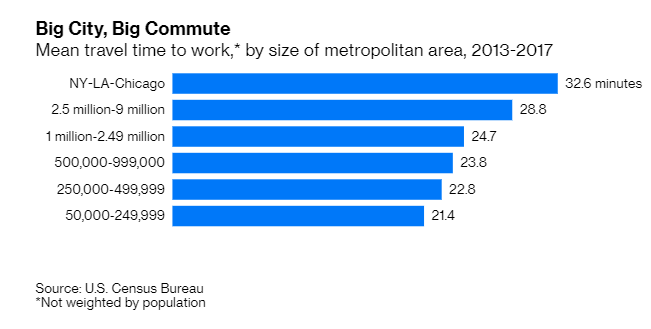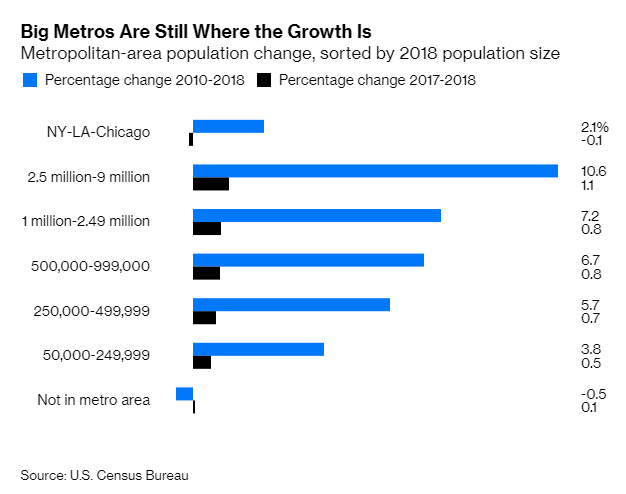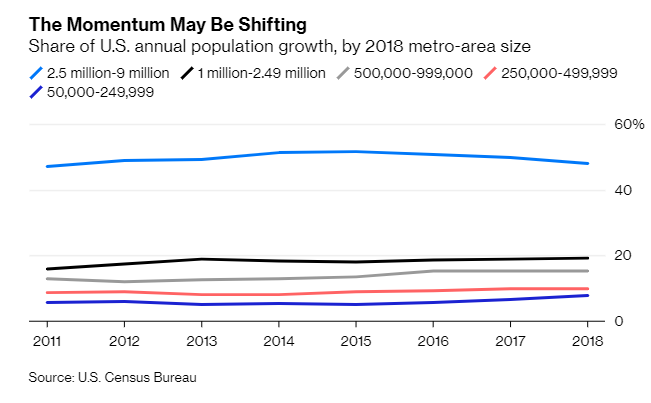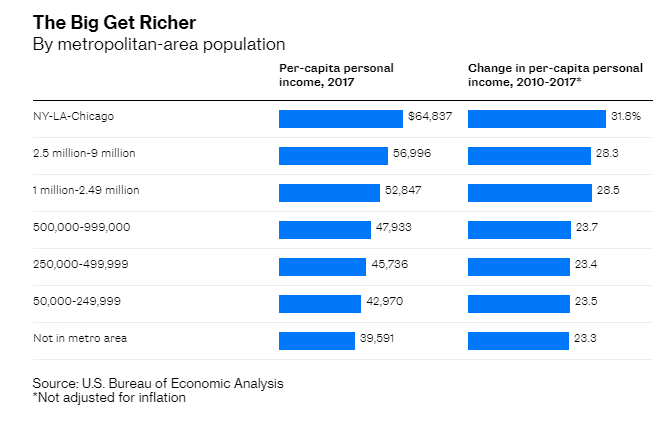The era of the mid-sized metro area is back, according to a new Bloomberg op-ed. In fact, for the first time since 2007, midsize metropolitan areas in the United States grew faster than large ones in the year ended July 1, 2018. The areas, with populations between 250,000 and 999,000, grew 0.8% versus 0.7% for large metropolitan areas. That data could signal that growth may be shifting back to smaller areas.
As we just wrote about, large metropolitan areas like New York, LA and Chicago have seen their populations dwindle in recent years. However, most of the rest of the country is still seeing growth.
The 21 metro areas with more than 2.5 million and less than 9 million people accounted for 48.1% of US population growth from 2017 to 2018. These metro areas make up 20.3% of the country’s population. Overall, 56.2% of Americans lived in the 53 metro areas with 1 million people or more in July 2018. This figure is up from 54.6% in 2010 and 56.1% in 2017. And so even though the country may not necessarily be getting more urban, it is definitely getting more metropolitan.
And signs of a momentum shift are becoming clear. There’s been an inflection since 2015 away from large metro areas and towards mid-sized and smaller ones.
One way to look at this is “as a contest between economics and livability”, according to the op-ed. The bigger areas continue to have an advantage in the former, as incomes rise with their population, and growth in per capita income from 2010 to 2017 has also generally favored the large areas.
University of California at Berkeley economist Enrico Moretti wrote in 2012: “Large metro areas have been experiencing more income growth because the knowledge economy has an inherent tendency toward geographical agglomeration.”
There are still smaller metro areas that outdo bigger ones in things like percentage of the population with college degrees, but larger metro areas have had an advantage in attracting these people, because their size offers them more opportunities. If your first job doesn’t work out, for instance, there’s probably another one right around the corner. But the trade-offs of large metropolitan areas remain longer commutes and higher costs.

And large metropolitan areas have had the edge in harder to measure aspects of livability, including entertainment and food quality. Many metro areas with populations between 250,000 and 999,000 offer great restaurants, cultural attractions and appealing neighborhoods.
The mid-sized metro revival should be welcomed, the piece concludes, arguing that the shift is a remedy to the concentrations of wealth in large metropolitan areas, where proposed solutions like subsidizing moves to higher-income regions and dismantling zoning regulations and other barriers to housing construction in in-demand cities are not getting traction.
And the belief that the comeback can continue is real. Brookings Institution’s Alan Berube wrote in January:
Although these regions lack the size and global reach of their much larger metro counterparts, they arguably retain the requisite scale to offer a distinctive economy and quality of life to their businesses and residents. Moreover, their size may also facilitate the sort of pragmatic, cross-sector problem solving that often bedevils larger metro areas; to wit, the average midsized metro area encompasses just 2.8 U.S. counties, versus 8.2 counties in the average large metro area.
You can read the full op-ed here.
via ZeroHedge News http://bit.ly/2VokffC Tyler Durden


